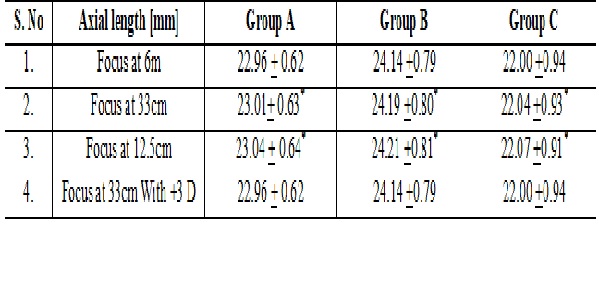A study of changes in axial length of eye during accommodation in Indian population
Abstract
Purpose: We performed this study to measure the changes of axial length during accommodation and see whether refractive error has any influence in effect of changes during accommodation.
Method: This study included 75 subjects who were divided into three groups according to refractive status. Axial length was measured before and after accommodation with A-scan. Accommodation was achieved by asking the subject to focus on N/6 line of near vision chart held at a distance of 33 cm with left eye with full refractive correction on the left eye.
Results: The mean increase in axial length was 0.051, 0.004, and 0.005 mm in Groups A, B and C respectively when focus of the left eye was shifted from 6 m to 33 cm. On further increasing the accommodation by shifting the focus of the left eye to 12.5 cm, the axial length increased by 0.08, 0.07, and 0.007 mm in Groups A, B, and C respectively. There was no significant difference in between three groups in these changes.
Conclusions: There was tiny but statistically significant increase in axial length along with accommodation in this study. This may be indirectly linked to the causation of myopia. There was no variation with refractive error in these changes.
Downloads
References
2. Fisher RF. Is the vitreous necessary of accommodation in man? Br J Ophthalmol 1983;67 (3): 206.
3. Read SA, Collins MJ, Iskander DR. Diurnal variation of axial length, intraocular pressure, and anterior eye biometrics. Invest Ophthalmol Vis Sci 2008; 49 (7): 2911-8.
4. Storey JK, Rabie FP. Ultrasonic measurement of transverse lens diameter during accommodation. Ophthalmic Physiol Opt 1985;5(2):145-8.
5. Drexler W, Baumgartner A, Findl O, Hitzenberger CK, Fercher AF. Biometric investigation of changes in the anterior eye segment during accommodation. Vision Res 1997;37(19): 2789-800.
6. Garner LF, Yap MK. Changes in ocular dimensions and refraction with accommodation. Ophthalmic Physiol Opt 1997; 17(1):12-7.
7. Calmettes, Deodati, Huron, Bechac. Study of the depth of the anterior chamber-physiological variations with particular emphasis on ametropia. Am J Optom Arch Am Acad Optom 1966; 43(12):765-94.
8. Kaluzny BJ. Anterior movement of the crystalline lens in the process of accommodation in children. Eur J Ophthalmol 2007; 17(4): 515-20.
9. Coleman DJ. Unified model for accommodative mechanism. Am J Ophthamol 1970; 69(6):1063-79.
10. Shum PJT, Ko LS, Ng CL, Lin SL. A biometric study of ocular changes during accommodation. Am J Ophthalmol 1993; 115(1): 76-81.
11. Tokoro T. Developmental mecanism of low myopia and therapeutic possibilities. A review. Nihon Ganka Gakkai Zasshi. 1998; 102(12):796-812.
12. Ip JM, Saw SM, Rose KA, Morgan IG, Kifley A, Wang JJ, Mitchell P. Role of near work in myopia: findings in a sample of Australian school children. Invest Ophthalmol Vis Sci 2008; 49(7): 2903-10.

Copyright (c) 2018 Author (s). Published by Siddharth Health Research and Social Welfare Society

This work is licensed under a Creative Commons Attribution 4.0 International License.


 OAI - Open Archives Initiative
OAI - Open Archives Initiative



















 Therapoid
Therapoid

